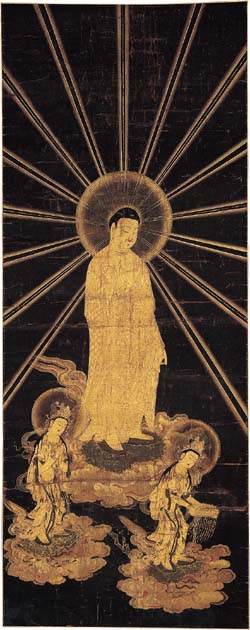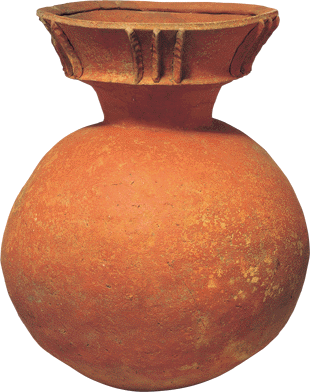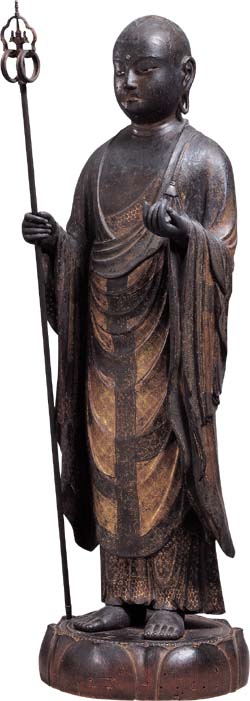 |
Raigô (Descent of Amida Budda)
Nanbokuchô period, 14th century
Color and gold (kirikane) on silk

Amida (Skt., Amitabha), the Buddha of Infinite Light, is depicted here descending gracefully on a cloud with his attendants bodhisattvas Kannon (Skt., Avalokitesvara) and Seishi (Skt., Mahashamaprapta), to welcome the devotee to the Western Paradise. According to Amida belief, his Pure Land is the most beautiful of all the Buddhist paradises, and Amida himself descends to earth to welcome adherents.

Here, Amida with his hands in the mudra of welcoming devotees to the Pure Land is led by his attendants. Kannon, with knees slightly bent and posture leaning over, holds a lotus pedestal for the devotee, who will be escorted to the Pure Land, and Seishi, striking a similar pose with knees bent and posture leaning forward, holds his hands in a gesture of reverence. Golden rays of light emanate in all directions from the mandorla behind Amida’s head. The contours of the Buddha and his attendants are delineated in thin red lines. Cut gold leaf is generously applied to create the decorative forms and details of Amida’s robe, as well as the finely preserved gold lines radiating from his head. The application of green pigment for the lotus daises and blue pigment for the background represents a technique that can often be seen in
Amida raigô images.
|
Standing Jizô Bosatsu
By Kaikei
Lacquered Japanese cypress (hinoki) with polychrome and cut gold leaf, inlaid crystal eyes, metal staff
Kamakura period, 13th century

Jizô (Skt., Ksitigarbha) is a bodhisattva believed to save sentient beings for 5670 million years between the death of the historic Buddha Sakyamuni and the future Buddha Miroku (Skt., Maitreya). For this reason, unlike other bodhisattvas who are bedecked in decorative robes and jewels, Jizô appears in the guise of a monk with head shaven. From the Heian period (794-1185) on, he is often depicted holding a staff in his right hand in order to express the idea that he is an itinerant, who does not live in the Pure Land, but stays in this world to save all beings.

Jizô Bosatsu here is rendered in the standard form with head shaven and body draped from the front to the left shoulder with a
kesa surplice over which he dons a fugen’e robe from right shoulder to right arm. In his left hand, he holds a jewel, and in his right, a staff. His left leg appears as if stepping out in his salvific journey. His firm facial features and slender body reflect his youthful spirit.

Japanese cypress in several pieces was used to carve this sculpture. The hollowed out head area was fitted from the interior with crystal eyes. And especially noteworthy is the intricate execution of the cut-gold leaf for the linked tortoiseshell and interlinked circle motifs on Jizô’s lavish kesa.

During a recent restoration, the dismantling of the statue led to the discovery of an artistic name inscribed within the back head section, which revealed that this work was carved by the renowned Kamakura-period (1185-1333) Buddhist sculptor Kaikei. The exuberant countenance as well as the solid natural physique of this image, wrapped in elegant robes, represents Kaikei’s early style. Jizô also embodies the highly sophisticated decorative techniques seen in Kamakura Buddhist sculptures. |



